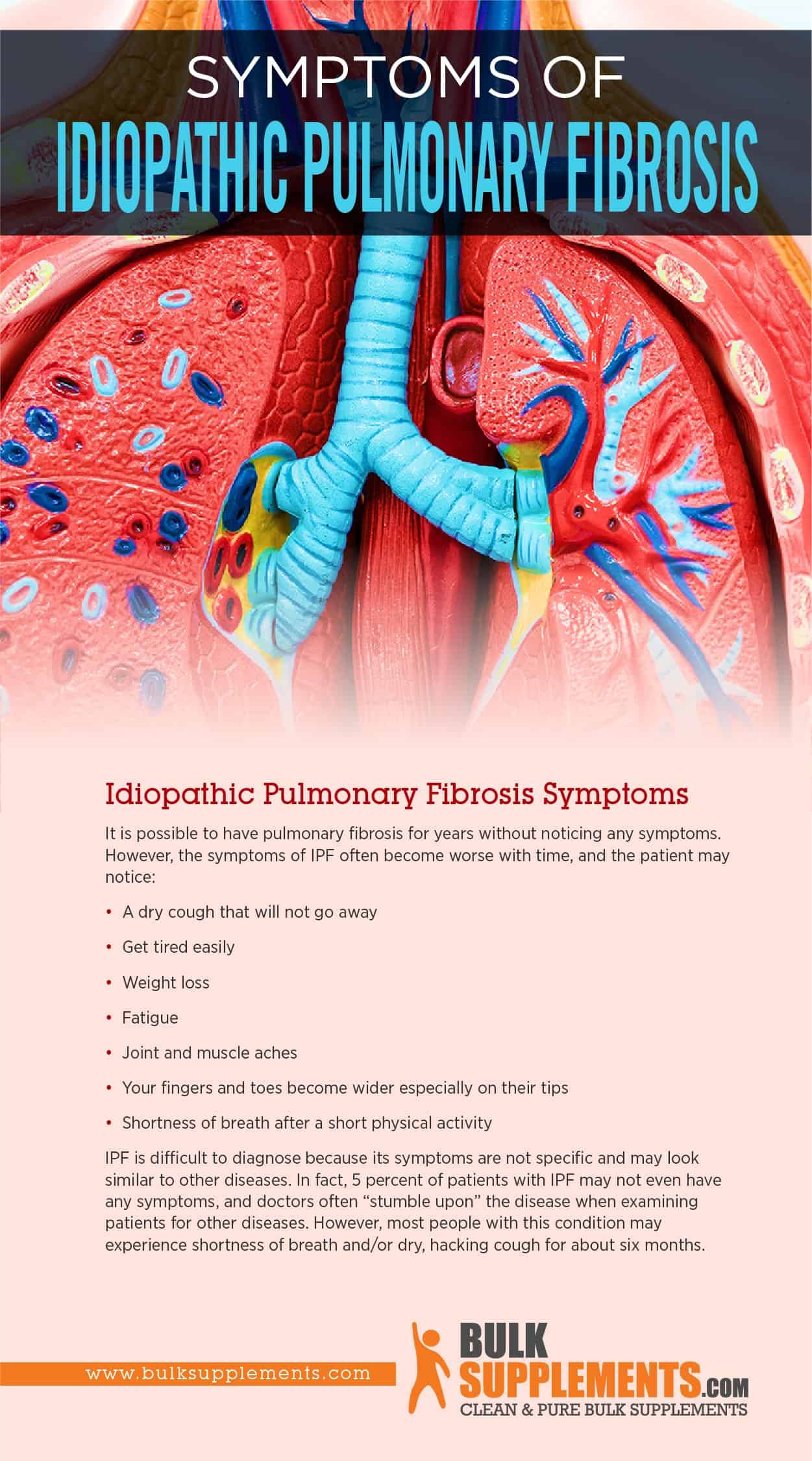Idiopathic Pulmonary Fibrosis: Symptoms, Causes & Treatment
by James Denlinger Digital Marketing StrategistWhat is Idiopathic Pulmonary Fibrosis?
Idiopathic pulmonary fibrosis (IPF) refers to the development of scar tissue inside the lungs. When you inhale, oxygen enters your lungs and is absorbed into the bloodstream where it travels to different organs in the body. Because of the thickness of the scar tissue that causes idiopathic pulmonary fibrosis, oxygen moves more slowly from the lungs and into the blood.
Idiopathic pulmonary fibrosis makes it more difficult for body organs to function. Also, the thick scar tissue that develops as a result of IPF makes it increasingly difficult to breathe. IPF does not have any known cure, though some medications can minimize damage to the lungs by slowing down the growth of scar tissue.
In many cases, the symptoms of IPF do not get better. Also, the outlook is different depending on the patient — some will experience deterioration faster while others may live with the condition for even a decade after diagnosis. A lung transplant may be the best solution in some cases.
Idiopathic Pulmonary Fibrosis Symptoms
It is possible to have pulmonary fibrosis for years without noticing any symptoms. However, the symptoms of IPF often become worse with time, and the patient may notice:
- A dry cough that will not go away
- Get tired easily
- Weight loss
- Fatigue
- Joint and muscle aches
- Your fingers and toes become wider especially on their tips
- Shortness of breath after short physical activity
IPF is difficult to diagnose because its symptoms are not specific and may look similar to other diseases. In fact, 5 percent of patients with IPF may not even have any symptoms, and doctors often “stumble upon” the disease when examining patients for other diseases. However, most people with this condition may experience shortness of breath and/or dry, hacking cough for about six months.
 PIN IT
PIN ITCauses of Idiopathic Pulmonary Fibrosis
Some people contract pulmonary fibrosis as a result of exposure to some elements in their environment, including pollution, medication and other infectious substances. However, doctors often do not know the exact condition of idiopathic pulmonary fibrosis in most cases.
Risk Factors
Pulmonary fibrosis can affect anyone, though many patients that have the condition are between 50 and 75 years old. Also, this condition is more prevalent in men than in women, and men often are diagnosed when the disease is at a more advanced stage. Other risk factors include:
Genetics
Some families are more susceptible to contracting IPF than others. In the case of familial IPF, people with close relatives who have the disease are more likely to have it at some stage in their lives.
Smoking
Experts believe there is a link between smoking and IPF. Moreover, people with hepatitis, herpes and Epstein-Barr virus have a higher risk of contracting pulmonary fibrosis.
GERD
Having gastroesophageal reflux disease (GERD) also increases the risk of pulmonary fibrosis. Experts suspect that GERD may cause patients to inhale tiny drops of stomach acid that may cause the development of scar tissue with time.
Working with Wood or Metal
The risk of IPF is also higher in people who breathe in lots of particulates at work, including wood or metal dust.
Idiopathic Pulmonary Fibrosis Diagnosis
Telling idiopathic pulmonary fibrosis apart from other lung conditions is often difficult because they share the same symptoms. Getting the right diagnosis may take some time and multiple visits to the doctor.
Medical History
If you have been having trouble breathing for a prolonged period, consider seeing a doctor. The doctor will examine you and ask you a few questions to establish your medical history. Some of the things your doctor may want to establish include:
- How long you have been experiencing the complication
- If you smoke or have ever smoked
- Whether you work with chemicals or not
- If you have a family history of IPF
- Whether you have any other lung or health complications or not
- If you have hepatitis, HIV, flu or Epstein-Barr virus
Diagnostic Tests
The doctor is likely to perform additional tests to confirm the diagnosis. Standard tests for pulmonary fibrosis include (x):
- Chest X-rays to obtain images of the lungs
- Exercise test where the doctor asks the patient to walk on a treadmill or do any other physical activity to check for oxygen levels in the blood through a probe attached to the fingertip or forehead
- Computed tomography or high-resolution CT scans to provide detailed images of the lungs — this test helps to determine the severity and cause of IPF
- Biopsy, which involves removing small tissues of the lungs and examining them under a microscope — this may be done with the aid of a device known as a bronchoscope or a special fluid to wash down the lungs and collect tissues for study
- Pulse oximetry to measure oxygen levels in the lungs
- Spirometry to determine if your lungs are working normally
However, there is no single test that can diagnose pulmonary fibrosis. In fact, lab tests are only done to exclude other medical conditions with similar symptoms. And even then, close to a third of patients with IPF may have positive tests for rheumatoid factor and/or antinuclear antibodies.
Although high resolution computed tomography (HRCT) is often used for diagnosing lung disorders due to its sensitivity, it does not provide definite tests for IPF. On the other hand, pulmonary function tests can provide useful information that can help in the diagnosis of IPF, especially when it is done repeatedly for about six months or longer.
Idiopathic Pulmonary Fibrosis Remedies
Although no medication can cure pulmonary fibrosis, some drugs can help patients breathe easier. Other drugs can help prevent the scar tissue inside the lungs from spreading or becoming larger. A doctor may recommend:
Medication
Nintedanib and pirfenidone are drugs that are known to slow down scarring and damage to lung tissues.
Oxygen Therapy
This therapy involves breathing oxygen through a mask or prongs. This treatment option helps to increase blood oxygen levels so that patients can continue with everyday activities without experiencing shortness of breath. The intensity or frequency of oxygen therapy depends on the severity of your condition. Some people require oxygen 24/7, while others need it only when they sleep or exercise.
Pulmonary Rehabilitation
This is another treatment option for pulmonary fibrosis. It involves working with doctors, nurses and therapists to find out ways of managing or improving your symptoms. These health professionals often ask patients to focus on saving energy, relaxing, eating healthy and stress relief.
Lung Transplant
Doctors recommend this treatment option to people whose condition is severe, with no signs of improvement. A lung transplant is a major surgery that can help patients to live longer.
If a patient fits the criteria for a lung transplant, they are put on a waiting list for a lung from a donor. Once the patient gets a lung from a donor, doctors will prepare them for lung transplant surgery, before doing the procedure. After the transplant, the patient may have to stay in the hospital for about a month or longer. To prevent the body from rejecting the new organ, the patient may have to take medication for the rest of his/her life. In addition, the patient will have several tests to see if the new lung is working correctly.
Supplements for Minimizing Idiopathic Pulmonary Fibrosis Symptoms
Pure Diindolylmethane (DIM) Powder
The DIM supplement is made from a naturally occurring substance and is believed to support immune health and metabolism. As a supplement, we recommend taking 100-200 milligrams no more than twice per day. Be sure to use a milligram scale to ensure accurate measurement. Speak with a doctor for supplementation instructions if you have liver or kidney diseases, cancer, and food allergies.
Do not supplement with DIM powder if you are expecting or nursing. Also, keep away from pets, including cats and dogs. Consider taking with vitamin E or foods rich in natural oils to facilitate absorption.
Pure Quercetin Dihydrate Powder
Quercetin powder supports cardiac, lung, kidney and liver health. It is rich in antioxidants that help the body to fight off infections. The safe dosage for this supplement is between 250 and 500 milligrams taken three times per day. Although this product is not highly soluble in water, it mixes very well with oils such as coconut and olive oil.
Consult your doctor for supplementation guidelines if you are using vitamin C supplements, are on antibiotics, have high blood pressure, or have problems with blood clotting. The same applies to people who are on hormone replacement therapy because the supplement can affect the production and secretion of the hormone estrogen. Pregnant women and those who are nursing should not use this product. Unfortunately, this product is not available to customers in Germany due to import restrictions.
Omega 3-6-9
Omega 3-6-9 is an excellent antioxidant for people with pulmonary fibrosis. It supports overall health, including cardiac and respiratory system health. It is rich in omega fatty acids derived from flaxseed oil, fish oil and primrose oil. The standard dosage for this supplement is three soft gels three times per day.
Side effects are not common; however, users may experience nausea, flatulence and burping. These side effects often disappear once you reduce the dosage. See a doctor immediately if you start experiencing swelling, itching or development of a rash.
Pure Ginseng Root Extract Powder
Ginseng provides an energy boost that enhances athletic endurance. For the right effect, take 1,000 to 2,000 milligrams up to two times per day. Despite its health benefits, avoid supplementing daily for more than six months without resting. Side effects of ginseng include abdominal discomfort, mood changes, low appetite and insomnia. Therefore, it is best that the following avoid taking ginseng root extract powder: pregnant and lactating women, and people with high blood pressure, schizophrenia, cardiac conditions and autoimmune disorders.
N-Acetyl L-Cysteine (NAC)
NAC supports liver and digestive health. It is also a powerful antioxidant that is rich in amino acids. The suggested serving size for NAC is 600 milligrams taken three times per day. Discuss supplementation with a health professional beforehand if you have diabetes or a cardiac condition.
Side effects associated with overdose include nausea, headache and vomiting. It is okay to mix this supplement with water or juice before use. Unfortunately, NAC is restricted for sale in the Netherlands, Germany and Sweden.
Glutathione
Glutathione has antioxidant properties that minimize aging and helps the body to fight off disease-causing pathogens. Take between 50 and 500 milligrams of this supplement per day. In addition, consider taking with food to maximize absorption. This product loses its potency when exposed to direct light, moisture or heat. Glutathione is not safe for use by pregnant and nursing women.
The Bottom Line
Idiopathic pulmonary fibrosis occurs when there is scar tissue in the lungs. While it is not known what exactly causes the condition, there are risk factors associated with the condition. Currently, pulmonary fibrosis does not have a cure. However, doctors can prescribe medication to help improve patient symptoms.
Sponsor Ads
Created on Mar 18th 2020 11:32. Viewed 424 times.




